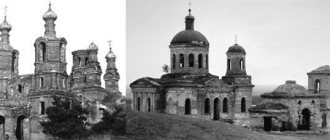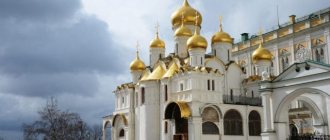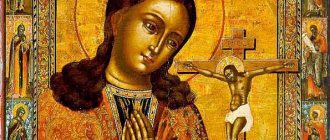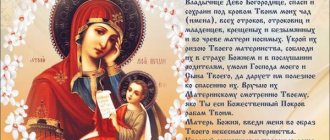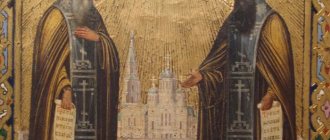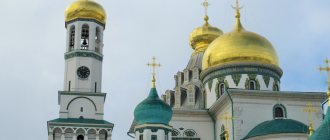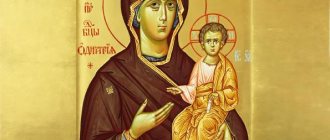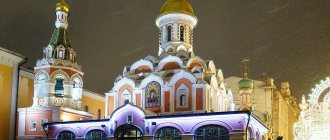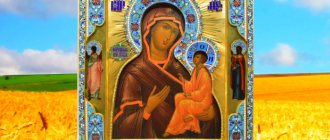Many secrets and unsolved mysteries are associated with the Andronikov Icon of the Mother of God. This icon is one of three painted by Luke. It is also known that for a long time the icon was kept by Andronikos III Palaiologos, emperor of the Byzantine Empire, and the icon was named in his honor. The first documented mention of the icon dates back to 1347 AD. This year Andronik donated an icon with the face of the Mother of God to the monastery in the city of Morea.
Celebration days:
- May 14
- November 4
Only in the 19th century, under Nicholas I, did the shrine come to Russia. This is due to the attack of the Turkish invaders on Greece. The monastery servant managed to save only the icon of the Mother of God; he secretly sent it to a relative, a Russian general. In 1839, the icon was stored in Russia. For many years the icon was untouched; it also survived the revolutionary years, moving from one church to another. Unfortunately, in 1984 the miraculous icon was lost; it was stolen from the Kazan convent. The location of the shrine is still unknown.
Description of the Andronikov Icon of the Mother of God
The original Andronikov image is one of the rarest creations of the icon painter Luke. The icon was kept at the imperial court of Andronikos III until 1347, when surviving documents confirm that he transferred the shrine to the Monemvasia monastery. In this monastery, located on the Greek Peloponnese peninsula, the image remained until the beginning of the 19th century.
In 1821, at the height of hostilities on the peninsula, enemy troops and atheists devastated many Greek settlements, including Monemvasia. The abbot of the monastery named Agapius fled from the devastated monastery, taking with him only the miraculous Andronikovsky face of the Mother of God.
By the will of Agapius, after his death, the image passed to the Russian Consul General, who was the abbot of his relatives. The son of the consul, who inherited the shrine, in 1839 sent the Andronikov Icon from the Greek capital to Russia to Emperor Nicholas.
On the Andronikovsky face the Most Holy Theotokos is depicted in close-up up to the shoulder line. Virgo's pure gaze is filled with humility and sadness. The head of the Mother of God, submissively and sadly tilted to the side, is decorated with a crown placed on top of a red maforium.
The robe, crown and holy halo are decorated with openwork patterns, flowers, and stones. On the shoulders of the Mother of God are the stars of Bethlehem, as a sign of Divine holiness. The original and most of the lists have an elegant salary. The frame usually has multifaceted embossing and is also complemented with rhinestones and stones. Sometimes only the crown on the head of the Mother of God is decorated in the form of a frame.
On the original face on the neck of the Mother of God there was a bleeding wound. This miraculous phenomenon happened when one of the Turkish warriors struck the image with hatred with a sharp dagger. Blood immediately began to ooze from the wound. The same dagger made of Damascus steel was kept together with the icon in a special case in its lower part. Attached to the shrine was also an embroidered coat of arms in the form of a double-headed eagle, inherited from the Byzantine imperial court.
The original Andronikov Icon, painted by Luke, after being transferred to the imperial family, remained within the walls of the Winter Palace for almost 30 years. In 1868, the image was moved to the Trinity Cathedral of St. Petersburg. After 9 years, the shrine was transported to a women’s monastic monastery near Tver. In 1894, an icon was stolen by unknown persons from the Church of the Epiphany in the city of Vyshny Volochek, which is located in the Tver region. Since then, no traces of the shrine have been discovered.
The Most Holy Theotokos is depicted alone in the icon, without the Savior
Let's take a closer look at this image.
The icon belongs to the Agiosoritissa type, because she is depicted alone, without Christ. This type of icon is painted very, very rarely. Therefore, it is not always possible to see such an image in a temple.
Mary's face in the icon is kind, but sad. It was believed that it was captured here at the moment of the death of Jesus Christ.
Its size was small - only 35 centimeters by 25 centimeters. Moreover, the icon is very contrasting; the dark face of the Virgin Mary and the bright halo and crown create such an effect.
The Virgin Mary is depicted shoulder-length in a bright orange robe, her crown is decorated with precious stones.
The halo occupies almost the entire upper part, which speaks of the great position of the Mother of God.
You should also pay attention to the wound on Mary’s neck. Ancient legends say that this mark on the neck was left by a Turk who burned with enormous hatred for everything Divine, including icons.
He stabbed the icon with a dagger, but did not expect that the wound on the icon would actually begin to bleed
Meaning of the image
Icons depicting the face of the Mother of God are considered strong, capable of helping in any life situation, guiding them to the true path and protecting the worshiper. According to a widespread opinion among believers, the icon painter depicted the Mother of God at the sad hour when her crucified Son, Jesus Christ, died on the cross. The Virgin's gaze, full of sadness, traditionally expresses humility before God's will and the worldly fate of the child immaculately conceived and born by her, and also conveys the pain of maternal loss.
After praying in front of the image, many who turn receive help from the Mother of God. The icon, which can be found in most churches, is rightfully ranked among the highly revered shrines of the Orthodox Church.
The story of Peter and Fevronia
This story is known to us from the monument of ancient Russian literature of the 16th century, “The Tale of Peter and Fevronia,” written after they were canonized. The author made extensive use of folk legends transmitted orally, so “The Tale...” is more reminiscent of fairy tales rather than lives.
The younger brother of the Murom prince, Peter, while fighting the devil in the form of a serpent, received an incurable skin disease. One day, in a night vision, it was revealed to him that only the daughter of a simple tree climber, Fevronia, could heal him. The girl demanded that Peter marry her as a reward for the cure, and he agreed, but then broke his promise. When his body was again covered with ulcers, he fulfilled his promise and married Fevronia, who healed him.
When Peter, after the death of his brother, ascended the princely throne in Murom, the boyars unanimously opposed his wife because of her common origin and presented Peter with a choice: either she and exile, or the throne. This time Peter showed real courage and, together with his wife, sailed away in a boat from Murom. A rather rare icon of Saints Peter and Fevronia depicts this moment, with God’s blessing descending on the spouses.
In Murom, unrest and civil strife began, and in the end the boyars had to ask Peter and Fevronia to return. Their reign was wise and fair, and their lives were pious and devoted to good deeds. At the end of their lives they accepted monasticism, Peter under the name David, and Fevronia under the name Euphrosyne.
They died, as they asked the Lord, on the same day, and although they were in different monasteries, their bodies miraculously ended up in the same coffin. Inseparable during life, they remained together after death.
List of the Andronikov Icon in Pereslavl
In the city of Pereslavl-Zalessky, in a church on the territory of the Feodorovskaya monastic monastery, there is a copy close to the lost original, created using the lithographic technique. The Pereslavl copy of the Andronikov Icon is revered by believers and is ranked by the church among the miraculous images of the Mother of God.
The beneficial effect on those praying and the miraculous effects of the list are confirmed by numerous testimonies from those praying. In 2006, the shrine lost its myrrh.
The exact history of the origin of the copy is unknown. The icon was transferred to the temple by one of the parishioners in 1998. Surprisingly, at the same time another woman came to the church and brought an icon case, and it was ideal for a copy of Andronikov’s image.
Story
John was the son of an elderly, long-infertile couple, the temple priest Zechariah and the righteous Elizabeth, who was a relative of the Virgin Mary herself.
The family lived in the town of Ein Kerem, near Jerusalem. Now there is a Church of the Visitation here. It is built on the spot where the Virgin Mary and Elizabeth met when they were both pregnant. Mary then went home, and Elizabeth gave birth to John a few months later. Another church is located right where John's house was.
Soon after his birth, Herod ordered that all babies be killed. According to legend, Elizabeth took her son and left to hide him somewhere. And then the mountain opened up before her and she was able to hide there and save John.
And Zechariah, his father, as a priest, took part in services and rituals in the Jerusalem temple. Perhaps John himself became a priest. But in heart and soul he was more like the prophets of the Old Testament.
The 20th-century Jewish philosopher Abraham Heschel spoke of prophets as people with special ears who could hear things that other people could not hear.
Christian traditions place John the Baptist among such prophets as Elijah, Jeremiah, Isaiah - those who had this inner ear, receptive to the word of the Lord.
At the age of 30, John hears the Lord’s call to a special ministry. He must become the voice of one crying in the wilderness, the forerunner of the Messiah. He retires to the Judean desert and, dressed in clothes made of camel's hair, lives there as a strict ascetic and ascetic.
John lives and preaches near a river crossing in what is now Jordan. On the east bank of the Jordan River, his speeches resonate among the people of the country. Dozens of people come to listen to the prophet, because Israel has long lived in anticipation of the Messiah, the true king from the line of David.
We advise you to study How to be baptized correctly in church in front of an icon
And now John says to them:
He calls on everyone:
John preaches Baptism-Repentance for the forgiveness of sins and performs the ritual of immersion in the water of the Jordan River, which has always been considered the border of the Holy Land. Just as water washes the body, Repentance cleanses the soul.
John reminds his fellow tribesmen of one of the greatest prophets of the past - Elijah, who lived 8 centuries earlier. Not only did he preach in the same section of the Jordan River where Elijah lived, but he also dressed like Elijah—minimal clothing. He ate like Ilya. He even had a long beard, like Ilya.
John the Baptist came to fulfill the mission of the prophet Elijah; he was not his physical embodiment. Christ Said:
Soon a whole community of followers gathers around John, and two Galilean fishermen who came here, having traveled tens of kilometers on foot, Andrew and John from Bethsaida, also become his disciples.
Soon, Jesus of Nazareth himself appears among the crowd on the banks of the Jordan. Thanks to prophetic powers, John realized who was in front of him. Christ asks to baptize him.
The sinless Jesus compares himself with fallen, lost people in order to share with them the burden of sins and bring healing to their souls. Having received the Revelation about Jesus Christ, he tells the people about him:
John, in his speeches, increasingly begins to criticize the power of King Herod. And he begins to fear that John’s power over the masses might lead to unrest.
John criticized Herod for divorcing his first wife and marrying his brother's wife. We can also assert, based on the materials of the historian Josephus, that John did not approve of Herod’s actions at the political level.
John was imprisoned in a fortress. But even here he is not going to remain silent and continues to remain a threat to the royal family. Herodias, the same second wife of the king, is looking for a reason to deal with her enemy. She worries that the king disappears at night in prison, talking with John.
A suitable opportunity arose soon, during the celebration of the birthday of King Herod. The daughter of Herodias, Salome, danced in front of the guests. Her fiery dance delights the birthday boy. Herod promises her as a reward everything that she does not ask for. And she, after consulting with her mother, asks for the severed head of John on a golden platter. The head was presented as a gift to Salome, who took the dish and placed it at the feet of her mother Herodias. Thus, John the Baptist died as an unbending witness of the Truth of God.
How does an image help?
Copies of the Icon of the Mother of God of Andronikovskaya are presented in many Orthodox churches. Believers also purchase an image for a home prayer service, placing it in a place of honor in the house. The Mother of God, as the great intercessor and patroness of true believing Christians, helps those praying in solving various worldly, physical and mental problems.
Before the holy face of the Mother of God, depicted on the Andronikovskaya icon, they pray for the gift:
- health to body and soul;
- relief from debilitating ailments;
- fortresses of faith;
- fortitude;
- family happiness and prosperity;
- children and parental joys.
The prayers of those who turn before the image help to direct loved ones who have lost their guidelines in life onto the path of true faith. They often pray for children at the image, hoping for the protection of the children and the presence of the Mother of God. Prayers help to find family well-being, resolve disputes and conflicts.
Sincere prayerful speeches from righteous Christians living according to the laws of God will certainly be heard in Heaven. The person praying must lead a godly lifestyle and not violate the commandments of Christ.
Prayer to the Shrine
Before the Andronikovskaya icon you need to offer the following prayer:
“Oh, Most Holy Lady Theotokos! Thou art the Highest of all Angels and Archangels, and of all creatures, the Most Honest: Thou art the Helper of the offended, the hopeless Hope, the poor Intercessor, the sad Consolation, the hungry Nurse, the naked Robe, the sick Healing, Salvation of sinners, Help and Intercession of all Christians. Oh, All-Merciful, Lady and Lady Theotokos! Raise us from the depths of sin, and deliver us from famine, destruction, from cowardice and flood, from fire and sword, from the presence of foreigners and internecine warfare, and from sudden death, and from attacks of the enemy, and from all evil. Grant, O Lady, peace and health to Thy servant, all Orthodox Christians, and enlighten their minds and the eyes of their hearts to salvation, and make us, Thy sinful servants, worthy of the Kingdom of Thy Son, Christ our God, with His Father without beginning, and with the Most Holy and His Good and Life-giving Spirit, now and ever and unto ages of ages. Amen."
Fig. 4 The petition to the Mother of God should be pronounced with a pure heart and true faith. Otherwise, holy ascensions and lit candles will be meaningless.
It is recommended to read the prayer in an undertone, in a slightly chanting tone, placing the correct emphasis on each word, otherwise the entire meaning of the prayer may be distorted. A secluded place is chosen for this, away from prying eyes. You can’t pray just on a whim or at someone’s direction; everything should come only from the heart.
Veneration of the Apostle Luke
He was born in Antioch and was very educated. In his youth he studied Greek philosophy, medicine and painting. During the activity of the Lord Jesus on earth, Luke in Jerusalem saw the Savior face to face, heard the sermon and believed in it. Soon he was included among the seventy apostles and sent to preach, and on the way to Emaus he learned about the risen Lord.
After the condescension of the Holy Spirit to the Apostles, Luke returned to Antioch and worked with the Apostle Paul, with whom he traveled to Rome. At the request of Christians, the Gospel was written about 60 years ago, he is the author. Therefore, the icons of the evangelists include this ascetic.
After the death of the Apostle Paul, Luke preached the Gospel in Italy and Macedonia. He painted three icons of the Most Holy Theotokos and icons of the holy apostles Peter and Paul. This is why he is considered the founder of Christian iconography. In old age he continued to travel and preach in Libya, Upper Egypt and Greece. He wrote the Acts of the Apostles and was 84 years old when he was hanged from an olive tree at Thebes. Therefore, the icon of the Evangelist Luke may include this plot or signs of martyrdom. During the time of Emperor Constantine, the saint's relics were transported to Constantinople.
